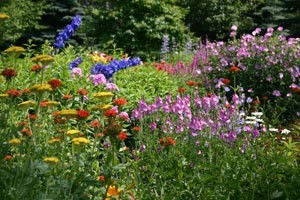
Technically speaking, a perennial plant is a plant that has a life cycle lasting longer than 2 years. But for most gardeners, perennials are more like old friends. When given the proper care, we can look forward to seeing them return to the garden year after year. Because there are literally thousands of kinds of perennials, it can be a bit overwhelming to try to figure out which type of perennial works best for different situations. Here are suggestions for 10 perennials in a variety of categories.
Maximize fragrant perennials by planting them near walkways, decks and close to doorways and windows. When people passing by brush plants, they will release the aroma of their leaves and flowers.
Hummingbirds and butterflies (flying flowers) are attracted to your garden by bright colored or tubular flowers that produce nectar. Here are 10 perennials they love:
Perennials with strong stems, attractive foliage and showy blooms make the best cut flowers for bouquets and arrangements.
Perennials for cut flowers are also often good as dried flowers. Pick them after midmorning dew has dried and dry them out of direct sunlight to prevent them from fading.
Perennial groundcovers are low growing plants, and provide useful solutions for places where little else will grow or where you want to conserve water, prevent soil erosion or reduce the growth of weeds. (* Denotes flowers that grows best in shade).
To keep the color show going all season long, plant a few perennials with long blooming periods (6 weeks of more). Make sure that some of them start blooming in the spring, some in mid-summer and some of them in the fall. (* Denotes flowers that grow well in shade).
These perennials are happiest under a canopy of dappled sunlight. In their natural habitats, these plants are often found in wooded areas and thrive in acidic soils that contain high amounts of rotted leaves.
When food is scarce, deer will eat anything. Under normal circumstance, however, deer will usually pass by these perennials:
Perennials with interesting foliage (interesting leaf shapes, colors, sizes and textures) add color and texture to your entire garden, even when they are not in bloom. (* Denotes flowers that grow well in shade).
Drought tolerant perennials, not to be confused with drought resistant perennials (perennials that are native to semi-arid regions) are perennials that have adapted or have been genetically changed to survive short periods of drought conditions. Of course the very best plants for drought tolerance are those that are native to your growing zone.

About The Author: Ellen Brown is our Green Living and Gardening Expert. Ellen Brown is an environmental writer and photographer and the owner of Sustainable Media, an environmental media company that specializes in helping businesses and organizations promote eco-friendly products and services.
Add your voice! Click below to comment. ThriftyFun is powered by your wisdom!